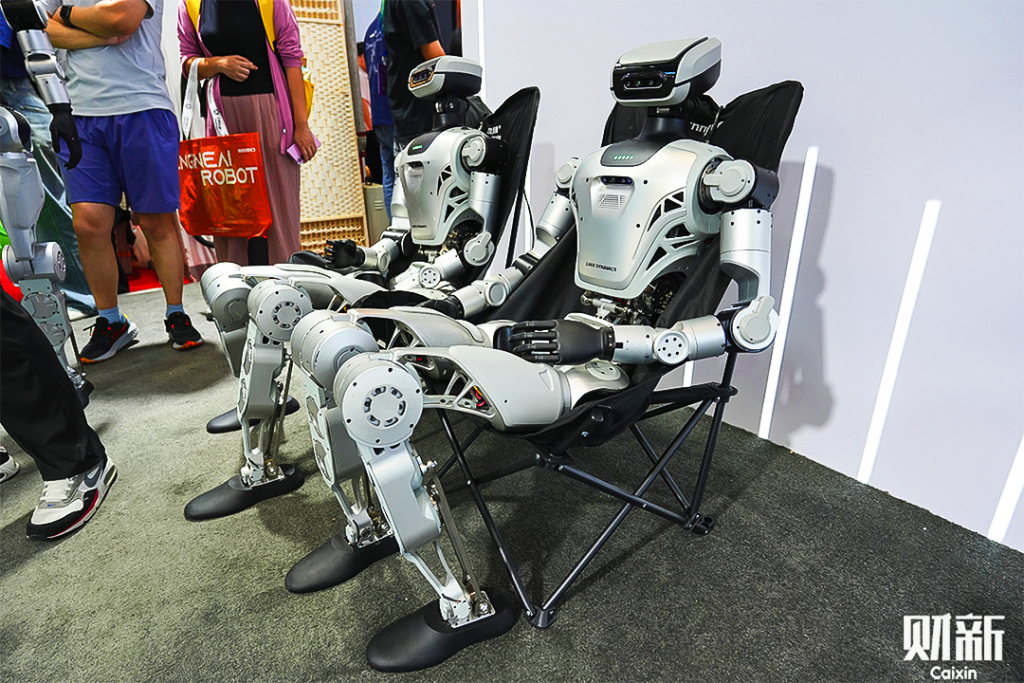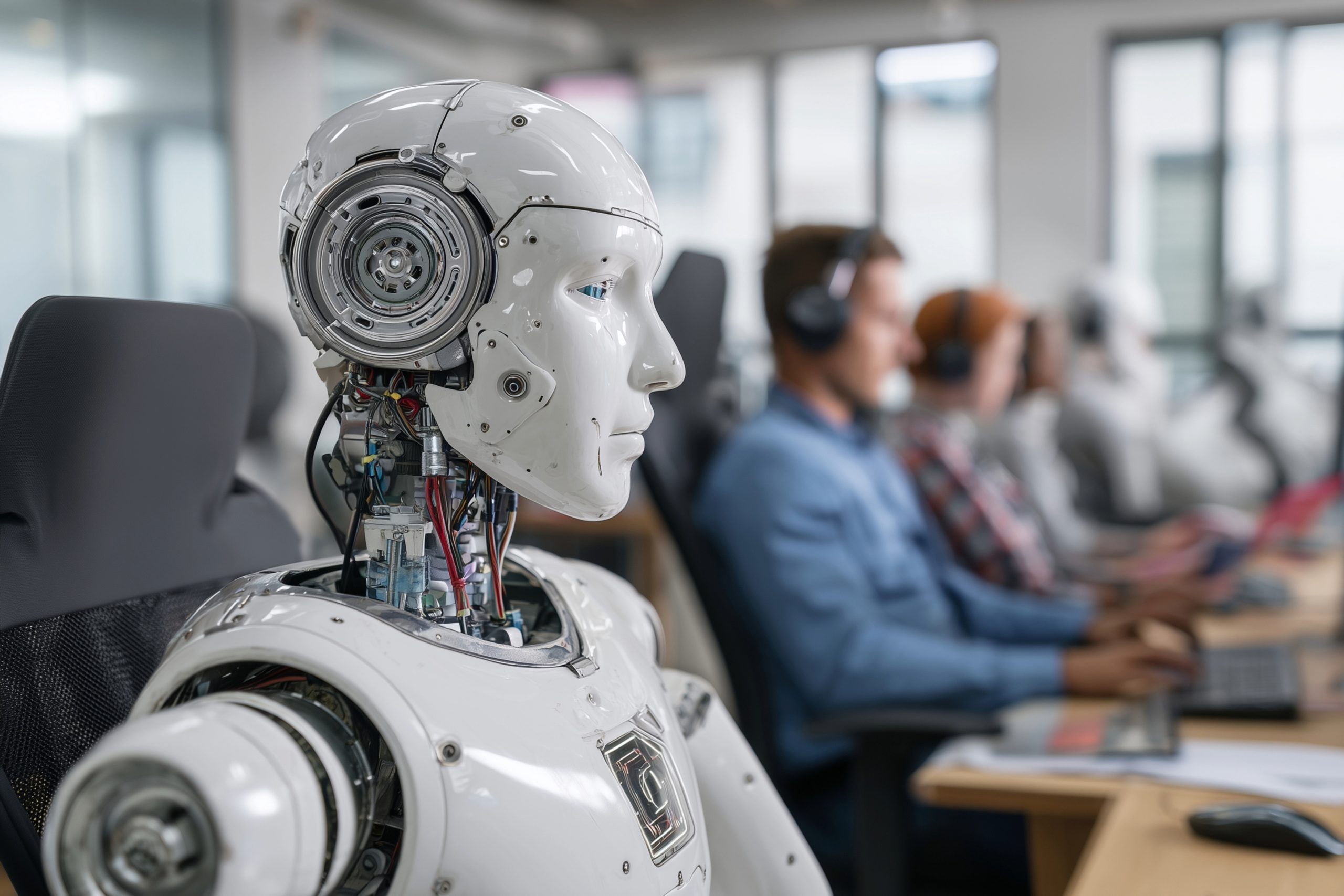In Depth: Humanoid Robots Need a Job
By Du Zhihang and Ding Yi


This year’s World Robot Conference (WRC) in Beijing, which wrapped up on Tuesday, hosted more than 200 robotics companies that showcased over 1,500 products, including humanoid robots capable of doing all sorts of things such as running, dancing and boxing.
Behind the slick demonstrations at the five-day event was a stark reality. While these robots can mimic certain human actions, they struggle to interact with their environment in real time or perform more complicated tasks. This has confined their uses largely to simpler roles in fields like customer service, with their application in industrial settings just beginning. For them to do more will require key technological breakthroughs.
“We don’t see any incremental value from humanoid robots’ application at the moment. And everyone is just excessively competing on cost,” a person working at a top Chinese wheeled humanoid robot firm told Caixin at the WRC. Even for wheeled humanoids, which are considered easier to take to market, achieving break-even on a single unit remains a distant goal.
Some companies like Unitree Robotics have cut the starting price of at least one of their humanoid robot models to as low as around 40,000 yuan ($5,566), but lower pricing means limited capabilities.
The market prices of humanoid robots displayed at the WRC range from tens to hundreds of thousands of yuan. Robots capable of boxing and dancing are typically priced under 100,000 yuan, while those with capabilities like folding clothes and making coffee can cost up to 500,000 yuan. For humanoid robots to become a household staple, a significant cut in costs across the entire supply chain must be made.
Despite these limitations, investor interest in humanoid robots remains high. Kang Yu, general manager of the board office of Shoucheng Holdings Ltd., a state-linked tech investment company, told Caixin at the WRC that the financing of embodied artificial intelligence (AI) has progressed much faster than expected, with multiple firms now racing toward an IPO.
Embodied AI refers to intelligent systems with physical forms that interact with the real world, such as robots and autonomous vehicles.
Models vs. data
At the heart of the technological challenge is a debate: What is the primary bottleneck for embodied AI — the AI models or the data needed to train them?
At the conference, Unitree Robotics CEO Wang Xingxing argued that robot hardware is now technologically advanced enough. The biggest challenge, he said, is that the development of embodied AI models lags far behind that of large language models.
The brute-force method of “piling up” data, which has led to a qualitative leap for chatbots, does not work for the development of embodied AI, Wang said. Even with data, they cannot effectively be used in training, and closely watched vision-language-action (VLA) models are not the optimal architecture for embodied AI, Wand added.
Others disagree. Over the past two years, numerous embodied AI firms including AgiBot, Galbot and Galaxea AI have launched end-to-end VLA models. Some have set up “data factories,” employing workers to operate robots or wear specialized gears to collect operational data. Some are generating massive amounts of simulated environment data to train robots to perform tasks like a human.
Wang Qian, CEO of X Square Robot, a Chinese embodied AI company, argued that, in theory, all future general-purpose robot models will incorporate “vision,” “language” and “action,” and therefore they should be called VLA models. Although architectural details may differ, he said that decades of trial and error suggest an end-to-end, general-purpose model is the most viable technical path. He also stressed the importance of data, stating that difficulties in gaining high-quality, real-world data remain a bottleneck for technological progress. X Square Robot has developed its own data collection equipment and processing models to address this problem.
Chen Jianyu, founder of Chinese humanoid robotics firm Robot Era, offered another view, identifying model architecture as the top concern, followed by high-quality data, with the quality of robot hardware coming third. He believes that models determine where data should be collected, what types of data should be gathered, how much data need to be collected and how data can be used efficiently.
Mo Lei, vice president of AI² Robotics, a Chinese embodied AI developer, noted that embodied AI models are not powerful enough at the moment, which prevents humanoid robots from being used out-of-the-box and makes manual tuning a necessity if they are used for factory work.
A university professor attending the WRC told Caixin that many of the robots touted as being able to “work” in factories rely heavily on “traditional” AI technologies from the previous era of industrial robotics, such as autonomous navigation for transport routes. Only a small fraction of the technologies used in the robots, like object recognition and grasping, can be considered as newer embodied AI, the professor said.
High costs
With production capacity still limited, the costs of making humanoid robots remain high, and their prices are far higher than the masses can afford. While some manufacturers have cut prices, their products remain high-end consumer electronics, and are priced accordingly.
Digit Huaxia, a Shenzhen-based robotics firm, has set the starting price of its humanoid robot, named Xing Xing Xia, at 198,000 yuan. The company explained that because the robot is intended for commercial uses that require human interaction, it must be equipped with an expensive computing system to power its “brain,” inevitably driving up the price.
Dexterous hands — a key robot component — vary dramatically in price based on their capabilities. Lower-spec five-fingered dexterous hands, which are priced no more than 10,000 yuan, are favored by customers who just want to make their robots look good while dancing, according to Liu Xin, CEO of Botyard Intelligence, a Shenzhen-based company that develops dexterous hands. But in production scenarios, such as factory work, these inexpensive dexterous hands aren’t up to snuff.
A representative from a coffee-making robot company told Caixin that they initially equipped their robots with dexterous hands priced around 10,000 yuan each, only to find that they failed to perform the complex task of making coffee. As a result, the company had to choose a dexterous hand that costs 50,000 yuan.
The simplest dexterous hands can only grasp objects like a clamp. Better ones allow the thumb to touch the tips of other fingers. More advanced models can raise and wag an index finger or nimbly pick up objects with just two fingers. As dexterous hands become capable of performing more complex tasks, their prices will rise accordingly, according to Liu.
Funding frenzy
Even though commercial uses for humanoid robots that can be scaled up still appear a long way off, investor enthusiasm for the business is running high.
Excitement soared after the eve of the Lunar New Year this year, when a dozen of Unitree Robotics’ general-purpose bots danced a jig during the nationally televised Spring Festival Gala in China. The Hangzhou-based startup just completed a Series C funding round in June, Caixin learned.
A recent investment spree in embodied AI reached a climax last month in China, when a host of developers, including DexForce Technology, Galaxea AI, Tars and Robot Era, raised funds.
Companies primarily plan to use that capital to gather data, according to the chief operating officer at an embodied AI firm, which has spent tens of millions of yuan on a data collection center. The costs will jump to 200 million yuan if labor costs are added.
Another executive from a 3D data company told Caixin that a developer has to invest at least 1 billion yuan to collect the amount of data needed to make a humanoid robot that can work a brick-and-mortar retail job.
Some embodied AI developers are also receiving help from local governments. The Tianjin government provided policy support for the construction of an embodied AI data factory that opened in June. The facility is used to collect data on activities such as carmaking, electronics assembly and medical care, which are then used to train embodied AI.
Still, there are signs a reshuffle is coming. With more and more investors pouring money into embodied AI, a bubble is starting to form, said Cao Wei, a partner at Lanchi Ventures, who stressed that his company will stick to its principle of investing in companies with long-term development potential as some might begin falling by the wayside in the second half of next year.
Another robotics industry investor said that any embodied AI company that cannot earn 400 million yuan in revenue this year won’t survive next year.
Contact reporter Ding Yi (yiding@caixin.com) and editor Michael Bellart (michaelbellart@caixin.com)
caixinglobal.com is the English-language online news portal of Chinese financial and business news media group Caixin. Global Neighbours is authorized to reprint this article.
Image: lashkhidzetim – stock.adobe.com
